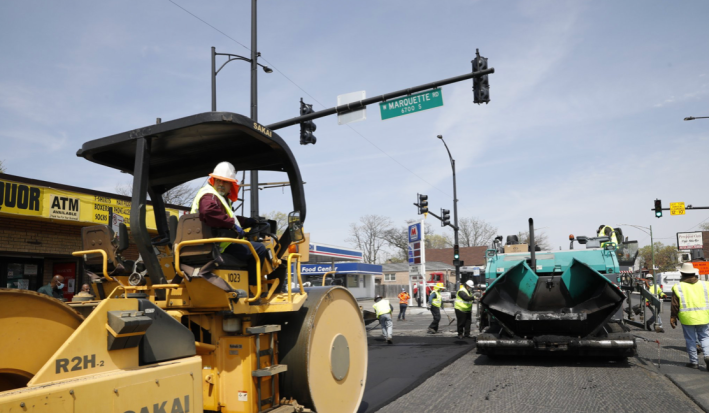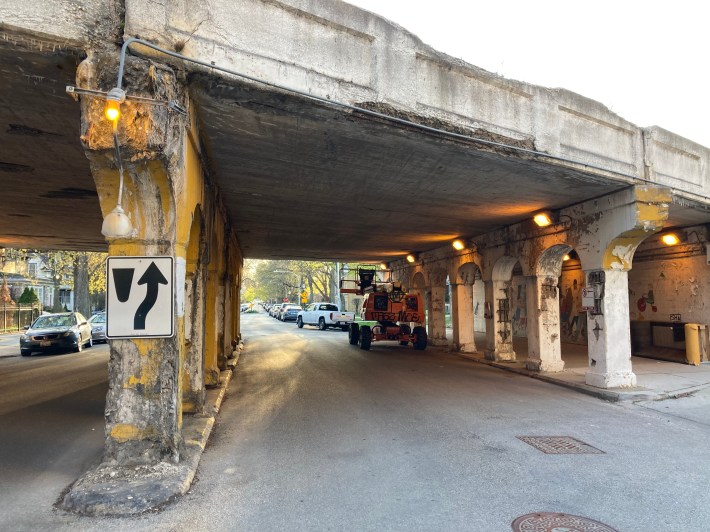Advocates: Lightfoot’s infrastructure plan may be more of the car-centric status quo
7:43 PM CDT on April 27, 2021

The “Blue Wave” bridge at 41st Street and the lakefront, one of three recently completed or planned bike-ped bridges over Lake Shore Drive. Photo: John Greenfield
Update 4/28/21 3:15 PM: The Chicago Department of Transportation provided this statement in response to the Active Transportation Alliance's letter about the Chicago Works plan:
"ATA is correct in stating that Mayor Lightfoot’s Chicago Works capital plan 'offers Chicago an extraordinary opportunity to show how investing in smart infrastructure can help spark and sustain an equitable recovery from the COVID-19 pandemic.'
In addition, as the mayor indicated, many of the infrastructure investments funded by the Chicago Works plan are being prioritized through a needs-based and data-driven process that takes into account the age and physical condition of our critical assets, including bridges, viaducts, street lights, sidewalks and ADA crosswalks and roadways and alleyways."
Yesterday Mayor Lightfoot announced the launch of the five-year-multi-billion-dollar Chicago Works infrastructure plan, starting with an increase in street repaving. But local transportation advocates say the mayor's plan won't provide the kind of transformative change needed our city needs to create a safer, more equitable, and more efficient transportation system."
The 2021 first installment of the plan includes over $600 million of capital projects across the city. "The plan relies on data to select and prioritize investments across the full array of public assets, addressing the worse first, along with an emphasis on equity and safety in order to create jobs and spur the city’s recovery from the COVID-19 Pandemic while addressing decades-long backlog of infrastructure needs," city officials stated in a news release.
Over the next two year, the Chicago Department of Transportation plans to use federal and state funding, plus money from the city coffers to repave 75 miles of arterial streets annually; nearly double the miles of a typical year, the news release said. Likewise, 500 more side street blocks will be repaved annually (1,240 blocks per year versus 740 blocks in past years.)

The city says Chicago Works will earmark money to fix and rebuild infrastructure like roads, bridges, sidewalks, wheelchair ramps, streetlights, and stoplights. It also includes cash for nine new streetscape projects project in lower-income communities of color on the South and West sides, public art, new trees trees, and Complete Streets pedestrian and bike safety improvements. 2021 and 2022 construction is funded through $1.4 billion in General Obligation bonds that represent the first installment on the $3.7 billion, five-year Chicago Works plan.
"These improvements prioritize making it easy to safely move around the city in sustainable ways like walking, biking, and taking public transit while making our streets and our public way vibrant, safe, and inviting places,” said CDOT chief Gia Biagi in a statement.
The city says Chicago Works projects will address sustainability challenges in like greenhouse gas emissions, storm water management, and local air quality. "Notable investments will be made to improve conditions for residents who walk, bike and take public transportation, allowing for safer and more efficient citizen experiences across the city," the news release promises.
The plan also calls for addressing deferred maintenance needs in city buildings such like libraries, firehouses, and health centers. The city says it will also be upgrading its fleet vehicles, with a goal of having fewer and newer vehicles, which will require less space and parking, and provide better fuel efficiency, reliability, and safety features.
The city says most of Chicago Works programs require at least half of the work be performed by Chicago residents, and there will be a high priority placed on using POC, women-owned, and locally owned businesses.

Features of the first two years of funding include:
- Aldermanic Menu Program: $216 million over two years that includes increasing the yearly menu budget, per ward, from $1.32 million to $1.5 million.
- Bridges and Viaducts: $164.3 million to complete the funding for 23 bridge replacement projects, $66.2 million for 37 bridge repair projects, $16.9 million to rehabilitate 13 underpasses; and $7.5 million to begin the process of improving vertical clearance at 5 viaducts.
- Streets and Alleys: $250.4 million for residential and arterial street resurfacing based on the Pavement Condition Index and ADA Ramp needs. Also funds the reconstruction of WPA streets along with 100 new Green Alleys to improve drainage and sustainability; one green alley in each ward every year.
- Street Lighting: $112.3 million for the complete replacement of 300 blocks of lighting infrastructure, along with strategic targeted light pole replacements and wiring stabilization repairs.
- Traffic Signals: $28.4 million to modernize the city’s historically underfunded traffic signal system.
- Sidewalks and Pedestrian Right-of-Way: $112.2 million for sidewalk repair (hazardous, vaulted, shared sidewalk programs, ADA ramps, curb and gutter, and alley aprons) to increase accessibility and public safety.
- Complete Streets: $49.0 million for improvements to bike lanes, priority bus routes, pavement markings and Vision Zero pedestrian safety projects. $104.2 million towards the funding of 24 streetscape projects including those in Invest South/West Corridors. $6 million for planting 12,000 trees.
- Waterways: $12.3 million for the reconstruction of 1 mile of lakeshore encompassing Morgan Shoal and the expansion of the Calumet River Dredging Facility to ensure clean waterways for commerce on the Calumet River.
- Facilities: $132.5 million for renovations and system upgrades to public facilities such as Department of Family and Supportive Service centers, Chicago Department of Public Health locations, Chicago Public libraries, and dozens of non-public facing facilities. This budget also includes environmental remediation of city-owned land and demolition of hazardous buildings.
- Equipment: $162.1 million for the city’s fleet, equipment, and IT systems.
More info and updates about the program are available at www.chicago.gov/ChicagoWorks.
Reactions to the plan from sustainable transportation advocates
Although the announcement gives lip service to improving conditions for walking, biking and transit, local sustainable transportation advocates said the program doesn't go far enough in that direction, and lays down few specifics.
"We are concerned the plan lacks the detail and focus necessary to advance the city’s goal to create a more sustainable transportation network," said Active Transportation Alliance spokesperson Kyle Whitehead. "In addition, there’s been little transparency and no public input on project selection." The group sent a six-page memo to Lightfoot, Biagi, and the City Council "detailing where the city is falling short and what can be done to achieve real progress."
In a blog post, ATA dvocacy director Jim Merrell wrote that while he plan "highlights a number of inspiring and potentially transformational projects... the plan also risks missing out on some enormous benefits by taking a business-as-usual approach to transportation. The approach risks letting politically popular projects like car-centric re-paving beat out smart, long-term planning and investment in cleaner, healthier, and safer modes of transportation."
Merrell added that the plan also lacks specifics on how Complete Streets upgrades "will add up to producing an easy-to-use and accessible network of walking, biking, and transit options, and community engagement in the plan has been woefully lacking."
Recommendations in ATA's memo to city officials include:
- Create transparency and community accountability. Provide public forums for input on project development and planning decisions.
- Implement Vision Zero improvements. Develop a timeline and project schedule for traffic safety improvements on Vision Zero High Crash Corridors within the scope of the city’s 5-year capital plan.
- Jump-start stalled progress on protected bike lanes. Install at least 10 miles of protected bike lanes on key routes by 2023, prioritizing the South and West side routes that lack quality infrastructure.
- Deliver a network of dedicated bus lanes. Install at least 20 miles of bus lanes on high-ridership routes by 2023.
- Make streetscapes work for mobility. Set baseline design goals for all streetscape projects that emphasize and positively impact walking, biking, and using transit.
"We urge Mayor Lightfoot, City Council, transportation and transit agency leaders to take these steps to ensure the capital plan achieves its goal to encourage clean, healthy, and affordable transportation," Merrell concluded.
Metropolitan Planning Council transportation director Audrey Wennink indicated that the group is also worried that the plan doesn't provide enough opportunity for public input. "Taxpayers deserve a transparent process that defines the types and locations of projects selected and what benefits they will deliver to residents," she said. "We would like to see more clearly how all planned transportation investments support the city’s Complete Streets policy that explicitly prioritizes pedestrians first, transit second and bicycles third in roadway corridor investments."
Wennink added, using similar language as ATA, "The city also needs to demonstrate how the Chicago Works investments will contribute to a connected citywide network of bike lanes, priority bus lanes and ADA accessible pedestrian infrastructure that will deliver improved Vision Zero safety results."
Streetsblog Chicago cofounder Steven Vance also noted that the plan lacks specifics. "How many new bike lanes and street redesigns, including road diets, will result from this? How many bridge decks will get a bike-friendly treatment?" He added that he'd like to see CDOT prolong the life of pricey resurfacing, avoid the disruptive-to-bicycling pothole patches, and inhibiting the freeze-thaw cycle by sealing cracks in asphalt, a strategy he's seen in many other municipalities.
What do you think of Lightfoot's infrastructure plan? Let us know in the comments.
In addition to editing Streetsblog Chicago, John writes about transportation and other topics for additional local publications. A Chicagoan since 1989, he enjoys exploring the city on foot, bike, bus, and 'L' train.
Stay in touch
Sign up for our free newsletter
More from Streetsblog Chicago
Which Metra corridor would become more bike-friendly and greener under a new plan? Ravenswood!
The avenue is slated to get a new Neighborhood Greenway bike route, and the Winnslie Parkway path and garden will be extended south.
They can drive 25: At committee meeting residents, panelist support lowering Chicago’s default speed limit
While there's no ordinance yet, the next steps are to draft one, take a committee vote and, if it passes, put it before the full City Council.
One agency to rule them all: Advocates are cautiously optimistic about proposed bill to combine the 4 Chicago area transit bureaus
The Active Transportation Alliance, Commuters Take Action, and Equiticity weigh in on the proposed legislation.



